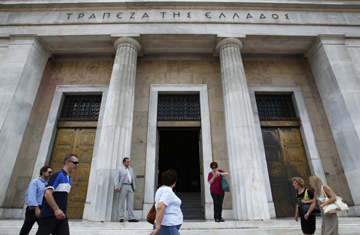
People walk outside the Bank of Greece in Athens July 20, 2010
European Union policymakers might like to think their emergency measures over recent weeks have calmed market concerns about shaky public finances in vulnerable euro-zone countries. But investors are still jittery, thanks to their niggling anxieties about the bad debts held in Europe's financial institutions. Market fears that banks are hiding their losses are hindering interbank lending, choking credit and stifling economic growth.
In a bid to reassure investors, the E.U. will publish on Friday the results of its so-called stress tests on banks. These much-anticipated tests open banks' books, examine bad losses, and check whether they have enough capital to absorb a new financial crisis. They should reveal whether Europe's banking sector really is solvent and, if there are pockets of capital weakness, force investors or governments to plug the gaps.
The tests offer the promise of restoring confidence in Europe's banks and boosting the economy as a whole — E.U. regulators point out that when the U.S. published public stress tests on its banks in 2009, the move helped halt the Wall Street panic. But the tests also carry a risk: if clumsily handled, instead of allaying anxieties, they could simply sow more fear.
So how can the stress tests ensure that markets are assuaged? The answer lies in the depth and transparency of the exercise, and the response by authorities to what the test reveals.
The tests were carried out by national banking supervisors and overseen by the European Commission, the European Central Bank and the Committee of European Banking Supervisors, a London-based umbrella group. The results will cover 91 banks accounting for 65% of the European banking system.
But the tests can only do the trick if they are rigorous enough, says Nicolas Véron, a senior fellow at Bruegel, a Brussels-based economic think tank. That means some banks will have to fail, or the whole exercise will look like a charade. "If the outcome is to be credible, the stress tests will necessarily reveal significant capital shortfalls in a number of banks. Otherwise, they will increase market distrust and volatility," he says. Véron warns that national authorities across Europe have incentives to protect "their" banks and sugarcoat the results: "Transparency is the key if the stress tests are to convince investors."
Observers expect that the tests will show most of the 91 banks can survive potential economic turbulence. But there are three areas that are considered particularly exposed: Greek banks, many of which hold significant sovereign debt; Spanish Cajas, or regional banks, which have been burned by the collapse in the country's real-estate market; and the German regional banks, the Landesbanks, which took heavy losses in the American mortgage markets. At Barclays Capital, analysts estimate that, when the test results are released, they will show that the Cajas may need $46 billion of extra funding, the Landesbanks $44 billion and Greek banks $11 billion.
Many analysts are also concerned that the tests may further damage confidence if they neglect to cover the risk of large losses on sovereign defaults by Greece and other susceptible euro-zone states. Understandably, E.U. governments are reluctant to entertain default scenarios, but a "sovereign shock" is precisely the sort of test investors will be looking for. According to a leak reported by Bloomberg, the E.U.'s tests assume some defaults and apply a discount, or "haircut", to some European bonds: a 17% loss on Greek bonds and 3% on Spanish bonds. This is far less than what investors expect, at least according to recovery swaps — hedges against defaults — which imply 50% losses in a Greek default or debt restructuring, and around 30% for Spain.
But perhaps the most important question surrounding the stress tests is how governments and the banks will respond. Investors will want to know how banks that fail will raise the extra capital they need. "Indentifying clearly the timing and source of funding — either via the market or the public sector — will be a key part of the exercise and fundamental to restoring confidence," says Silvio Peruzzo, a London-based economist with the Royal Bank of Scotland.
Governments prefer banks to rely on private means, such as asset sales and stock issues, to raise any extra capital. U.S. banks largely relied on their own means to reinforce reserves after their 2009 stress tests found 10 of the 19 scrutinized banks needed additional capital. But if European banks can't find the funds themselves, government intervention may be necessary, and ECB officials have urged countries to have financial safety nets in place to prevent any disorderly failures of banks. E.U. Economics and Monetary Affairs Commissioner Olli Rehn says, as a last resort, states could turn to the $950-billion loan package the E.U. set up in May to aid indebted nations.
Rehn, like many E.U. officials, says the tests should allow the eurozone to move beyond the current crisis. But the markets are still skeptical. "It is potentially a useful exercise," says Beat Siegenthaler, an analyst at UBS in Zurich. "But what we have seen so far is that the tests are not severe enough and everybody is looking out for their own banks. If things are being glossed over, then the mistrust among banks will remain and the stress tests will do nothing to soothe the markets." In other words, if the tests fail to convince, then Europe can bank on yet more stress.
